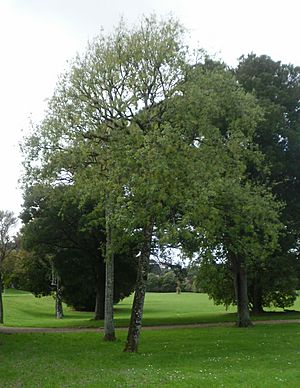Lowland Ribbonwood facts for kids
Quick facts for kids Ribbonwood/manatu |
|
|---|---|
 |
|
| Scientific classification | |
| Genus: |
Plagianthus
|
| Species: |
regius
|
The ribbonwood tree, also known as lowland ribbonwood or manatu (in Māori), is a special tree found only in New Zealand. Its scientific name is Plagianthus regius. Māori people also call it houi, manaui manatu, puruhi, and whauwhi.
What is Ribbonwood?
Ribbonwood is a unique tree because it's one of the few trees in New Zealand that loses its leaves in winter. This is called being deciduous. Most New Zealand trees stay green all year! In warmer northern areas, it might only lose some of its leaves, making it "semi-deciduous."
It's the biggest deciduous tree in New Zealand, and it can grow up to 17 meters tall. That's about as tall as a five-story building!
How Does it Grow?
When ribbonwood trees are young, they look quite different from older ones.
- Young trees: They have lots of tangled, crisscrossing branches with small leaves. This is called "divaricating" growth. It's like a messy bush!
- Older trees: As they get older, their leaves become much bigger. The lower parts of the tree might still have some of those tangled, small-leaved branches.
In spring, ribbonwood trees burst into bloom with lots of tiny white or green flowers. These flowers grow in thick bunches, making the tree look beautiful. This is a good way to tell it apart from similar trees like the lacebark.
Where Does it Live?
You can find ribbonwood trees all over New Zealand, from the North Island down to the South Island and even on Stewart Island.
There's also a very similar type of ribbonwood found on the Chatham Islands. It's called Plagianthus regius subspecies chathamicus. The main difference is that this subspecies doesn't have the tangled, divaricating branches when it's young.
How Was it Used?
In the past, the Māori people used the bark of the ribbonwood tree for many important things. They would use it to make strong materials for traditional textiles, like fishing nets.

